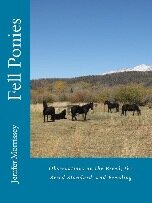Observations about Twinning in Fell Ponies
/Thanks to social media, the Fell Pony community in 2022 celebrated the birth and healthy rearing of a set of pony twins in England. Their breeder shared updates and photos so that we could follow their progress. The breeder said repeatedly that it was all about having an amazing mare able to carry them to term, birth them, and then nurse them. The breeder too deserves credit for supporting the mare with her double work load.
I have had the good luck to see a set of healthy Fell Pony twins. There’s nothing quite like it. On the other hand, I have also watched the heartbreak of a breeder who had a set of twins, one of which was much weaker than the other. The breeder tried desperately to save the weak one, but sadly it eventually passed. Fortunately for the mare, she still had a foal to mother. There have also probably been innumerable twins that were never viable and were aborted and we never knew about. So when a set of twins like this year’s is viable and makes it to weaning, they inspire us. Some this year have said that breeding for twins seems like a good idea. I would like to share some additional observations about twinning in Fell Ponies, based on personal observation.
One observation is that equines in general are really not well suited to raising two foals. That’s evident when so many are weak or unviable. One could argue that when a mare is successful, then there is great hope. That might be with that particular mare and her genetic and physiologic make up and perhaps even only when mated to that particular sire. A daughter, though, will only have some of her mother’s genes and physiology so there’s no guarantee that she will be as successful. That’s where it’s important to understand the range of possible outcomes of breeding for twins.
The healthy set of twins we saw in 2022 is one example of a possible outcome. So is the outcome of one healthy and one non-viable foal. As mentioned, at least in that case the mare has one foal to nurture. When both foals are lost, that is very tough on a mare, but there’s an even worse case scenario. The mare of the healthy twins that I met also had a daughter. That daughter had a healthy single foal for her first mothering experience. The second time though was twinning gone awry. If you are squeamish, you may wish to skip the rest of this paragraph. The mare foaled a healthy foal that stood and nursed and moved about. Except that the foal had two hooves on one of its front legs. And there was a bag of bones that was also birthed out. Apparently the two sets of genetic material were not properly divided. The foal had to be put down, and it was hard on the mare to not have a foal to rear after all the effort of gestation and delivery and knowing that it had nursed. The mare did have another healthy foal from her next pregnancy, but then she foaled another deformed foal the next time. Again the foal was put down and the mare had no youngster to reward her hard work. The mare was retired from breeding. So despite her mother having successfully raised twins, the daughter apparently had the twinning gene but could not be successful raising twins.
Breeding is a complicated craft. We care for animals, we study pedigrees, we try to match stallion and mare, we wait for nearly a year, and we hope for a foal we can enjoy. Twins can bring double the joy, but there is also the chance of tremendous heartbreak. So when twinning is present in a pony’s pedigree somewhere, we have difficult decisions to make on our own behalf but also for the mare and the foal. Each of us must make our own decisions, using all the information at our disposal and considering all the possible outcomes. And we can celebrate as a community when healthy twins are born.
© Jenifer Morrissey, 2022
There is an article on research about twins in Fell Ponies in my book Fell Ponies: Observations on the Breed, the Breed Standard, and Breeding, available internationally by clicking here or on the book cover.




